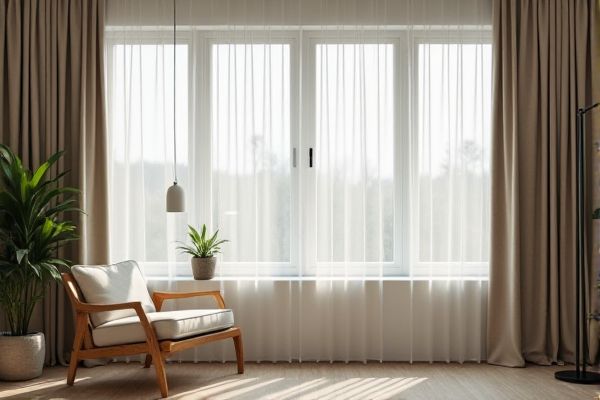
Vertical blinds offer precise light control and a modern aesthetic ideal for large windows or sliding doors, while curtains provide a cozy, decorative touch with diverse fabric options for insulation and style. Explore the rest of the article to discover which window treatment best suits your space and needs.
Table of Comparison
| Feature | Vertical Blinds | Curtains |
|---|---|---|
| Light Control | Adjustable slats allow precise light and privacy control. | Limited control; usually either open or closed. |
| Space Efficiency | Compact design; ideal for sliding doors and large windows. | Requires more space to draw open. |
| Maintenance | Easy to clean with wiping or vacuuming. | Requires regular washing or dry cleaning. |
| Durability | Made from PVC, fabric or aluminum; long-lasting. | Fabric can fade or wear over time. |
| Installation | Simple mounting on window frame or ceiling. | Requires rods and brackets; installation can be complex. |
| Style Options | Modern, minimalistic; limited patterns and textures. | Wide variety of fabrics, patterns, and colors. |
| Cost | Generally affordable and cost-effective. | Varies widely; often more expensive depending on fabric. |
Introduction to Window Treatments
Vertical blinds offer precise light control and a sleek, modern appearance, making them ideal for large windows and sliding doors, while curtains provide a softer, decorative touch with a variety of fabrics and patterns to enhance your room's ambiance. Both window treatments improve privacy and insulation, but vertical blinds are easier to maintain and clean, whereas curtains add warmth and texture to your space. Choosing between vertical blinds vs curtains depends on your style preferences, functional needs, and the specific lighting effects you want to achieve in your home.
Overview: Vertical Blinds vs Curtains
Vertical blinds offer precise light control with adjustable slats, ideal for large windows and sliding doors, providing a modern and sleek appearance. Curtains deliver better insulation and a softer aesthetic, enhancing room decor with various fabrics and patterns while also offering privacy and noise reduction. Choosing between the two depends on preference for functionality, style, and the specific needs of the space.
Aesthetic Appeal and Design Options
Vertical blinds offer a sleek, modern aesthetic with clean lines ideal for minimalist and contemporary spaces, providing excellent light control and privacy. Curtains bring warmth and versatility through diverse fabrics, patterns, and colors, allowing you to customize your room's ambiance and softness. Your choice depends on whether you prioritize streamlined functionality or rich, decorative design options.
Light Control and Privacy
Vertical blinds offer superior light control by allowing precise adjustment of slats to regulate sunlight and reduce glare, unlike curtains which often block light completely or not at all. Curtains provide improved noise insulation and a softer aesthetic but may lack the flexibility to tailor privacy levels effectively throughout the day. Your choice will depend on whether variable light management or a cozy ambiance is more important for your space.
Energy Efficiency and Insulation
Vertical blinds offer superior energy efficiency by allowing precise control over sunlight and heat entry, reducing cooling and heating costs. Curtains, especially those made with thermal or insulated fabrics, provide excellent insulation by trapping warm air during winter and blocking heat during summer. Your choice between vertical blinds and curtains impacts overall home energy savings and indoor comfort significantly.
Maintenance and Cleaning
Vertical blinds require less frequent cleaning and can be easily wiped with a damp cloth or vacuumed using a brush attachment, making them ideal for low-maintenance environments. Curtains often need regular washing or dry cleaning to maintain their appearance, especially if made from delicate fabrics prone to dust and stains. The material and design of vertical blinds typically resist dust accumulation better, reducing overall cleaning time compared to curtains.
Installation and Space Requirements
Vertical blinds require minimal installation space as they are mounted directly to the window frame or ceiling, making them ideal for compact areas. Curtains need more room for mounting rods and fabric to hang freely, often requiring additional wall space on either side of the window. Your choice between vertical blinds and curtains should consider available installation space and the ease of setup to ensure optimal functionality and aesthetic appeal.
Durability and Longevity
Vertical blinds typically offer greater durability and longevity compared to curtains due to their construction from robust materials such as PVC, aluminum, or fabric blends designed to withstand sunlight exposure and daily wear. Curtains made from natural fabrics may fade, tear, or deteriorate faster if exposed to direct sunlight and frequent handling, requiring more frequent replacement. Vertical blinds also benefit from easy maintenance and resistance to moisture, making them a longer-lasting window treatment option in high-traffic or humid environments.
Cost Comparison
Vertical blinds typically offer a more budget-friendly option compared to curtains, especially for large windows or patio doors, with prices ranging from $20 to $50 per panel. Curtains can vary widely in cost depending on fabric quality and design, often starting around $30 and reaching over $100 per panel for high-end materials. Your choice hinges on balancing initial installation expenses with long-term maintenance and aesthetic preferences.
Choosing the Right Option for Your Home
Vertical blinds provide excellent light control and are ideal for large windows or sliding doors, offering a modern, sleek look that complements contemporary interiors. Curtains add warmth and texture, coming in various fabrics and styles to suit traditional or cozy home designs, while also improving insulation and noise reduction. When choosing the right option for your home, consider factors such as natural light needs, room function, and aesthetic preferences to ensure the best fit for your living space.
 homyna.com
homyna.com